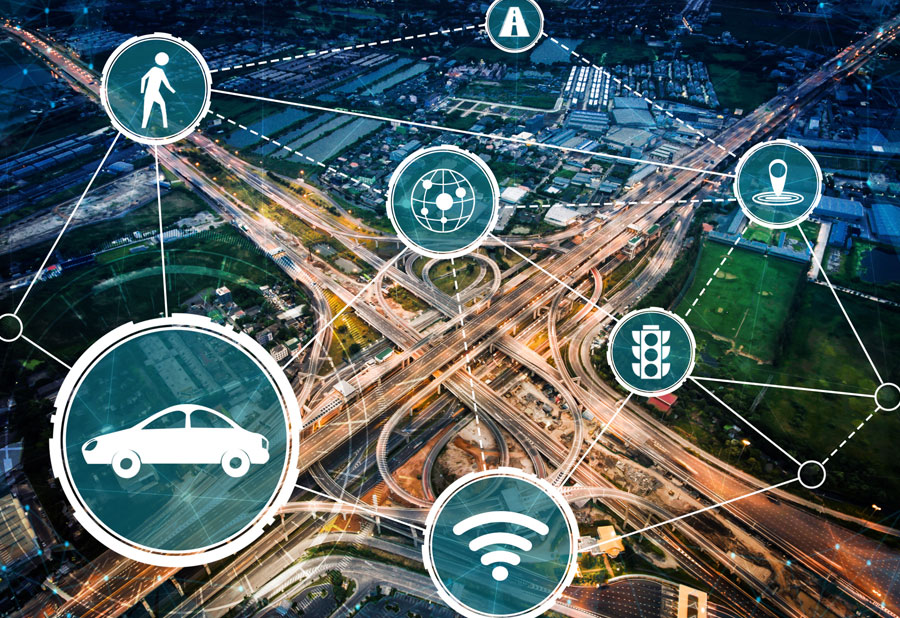Urban Air Mobility (UAM) refers to the integration of advanced aerial vehicles, such as drones and electric vertical takeoff and landing (eVTOL) aircraft, into urban transportation systems.
This emerging mode of transport aims to:
- alleviate ground traffic congestion
- expedite deliveries
- enhance emergency response services
by utilizing low-altitude airspace for the movement of goods and passengers within urban and suburban areas.
The concept encompasses a range of applications, from autonomous delivery drones to air taxis, and holds the potential to revolutionize urban logistics and infrastructure management.
Infrastructure Requirements for Integrating Aerial Logistics into Urban Settings
The successful implementation of UAM necessitates the development of specialized infrastructure to support the operation of aerial vehicles within city environments. Key infrastructure components include:
1. Vertiports
Vertiports are designated facilities that enable eVTOL aircraft to take off, land, recharge, and undergo maintenance.
Unlike traditional airports, vertiports are designed to integrate seamlessly into urban landscapes. Potentially being situated on rooftops, parking structures, or other urban spaces. Their strategic placement is crucial for optimizing route efficiency and minimizing urban congestion. The development of vertiports is poised to transform urban logistics by facilitating rapid and efficient aerial transportation of goods and passengers.
Vertiports should be designed for new connectivity, from the point of view of architecture, for city, airports, coastal areas, and rural environments. And, from the point of view of technology, for future autonomous flights with no pilots which will need more technology devices connected to other management systems, city alerts, risk and safety systems for a new transport paradigm of high automation.
2. Air Traffic Management Systems
Integrating a multitude of aerial vehicles into urban airspace requires sophisticated air traffic management systems to ensure safe and efficient operations. These systems must be capable of:
- managing both manned and unmanned aircraft
- preventing collisions
- preventing collisions
The development of dedicated low-altitude air corridors, often referred to as «highways in the sky,» is under consideration to facilitate organized aerial traffic flow.
3. Communication Networks
Reliable and secure communication networks are essential for the real-time exchange of data between aerial vehicles, operators, and air traffic control systems. This includes the transmission of flight data, navigation information, and emergency protocols. The integration of 4G/5G technology and dedicated communication channels is anticipated to support the low latency requirements of UAM operations.
4. Charging Infrastructure
Given the reliance on electric propulsion for many UAM vehicles, establishing a network of charging stations is vital. These stations should be strategically located at vertiports and other key points within the urban area to ensure operational continuity and efficiency. The development of standardized charging protocols will be essential to accommodate various types of eVTOL aircraft.
Regulatory and Expansion Factors Influencing Adoption
The widespread adoption of aerial logistics in urban environments is contingent upon addressing several regulatory and expansion challenges:
1. Regulatory Frameworks
Establishing comprehensive regulatory frameworks is paramount to ensure the safe and efficient integration of aerial vehicles into urban airspace. Regulations must encompass airworthiness standards, pilot certification, operational guidelines, and safety protocols. In October 2024, the Federal Aviation Administration (FAA) introduced a new category for powered-lift aircraft, setting the stage for the integration of air taxis and other eVTOL vehicles into the national airspace. Similarly, the European Union Aviation Safety Agency (EASA) has been proactive in developing regulations to facilitate UAM operations across Europe.
2. Public Acceptance
Gaining public trust and acceptance is crucial for the successful implementation of UAM. Concerns related to safety, noise pollution, and privacy must be addressed through transparent communication, community engagement, and demonstrable safety records. Studies have indicated that public perception significantly influences the adoption rate of new transportation technologies, underscoring the importance of addressing societal concerns.
3. Technological Advancements
Continuous advancements in autonomous flight systems, battery technology, and collision avoidance systems are essential to enhance the safety, efficiency, and reliability of aerial logistics. Investments in research and development will play a pivotal role in overcoming technical challenges and accelerating the commercialization of UAM services.
4. Economic Viability
The economic feasibility of UAM services depends on factors such as operational costs, pricing models, and market demand. Developing scalable business models that offer affordable services to consumers while ensuring profitability for operators is essential for sustainable growth in the aerial logistics sector.
Opportunities for Optimizing Urban Infrastructure Management
The integration of aerial logistics presents several opportunities to enhance urban infrastructure management in the coming years:
1. Alleviating Ground Traffic Congestion
One of the most promising advantages is the potential to alleviate ground traffic congestion. As urban populations grow and road networks become increasingly saturated, shifting a portion of transportation to the air can significantly reduce pressure on existing infrastructure.
Aerial vehicles can bypass traditional traffic bottlenecks, improving overall mobility within cities and enabling a more balanced distribution of transport demand. This shift contributes to smoother traffic flow and it also supports the development of more sustainable, pedestrian-friendly urban environments.
2. Expedite Deliveries
A second key opportunity lies in the ability to expedite deliveries, especially in the context of last-mile logistics. Autonomous drones and electric vertical takeoff and landing (eVTOL) aircraft are well-suited to navigate complex urban layouts quickly and efficiently.
Their use can dramatically reduce delivery times for critical goods such as medical supplies, perishable items, and e-commerce orders. By enhancing speed and reliability, aerial logistics strengthen urban supply chains and offer new models of service delivery that respond to the increasing demand for rapid, on-demand fulfillment.
3. Enhance Emergency Response Services
Lastly, aerial logistics can play a vital role in enhancing emergency response services. In situations where every second counts, such as medical emergencies, natural disasters, or large-scale accidents, aerial vehicles provide a powerful complement to traditional ground-based services.
Drones can deliver defibrillators, medication, or rescue equipment to hard-to-reach locations, while eVTOLs can transport medical personnel or patients more quickly than ambulances in congested areas. This increased responsiveness can improve outcomes, save lives, and add a new layer of resilience to urban emergency systems.
At Openvia, we are closely monitoring the evolution of Urban Air Mobility as it intersects with the future of digital infrastructure. Our goal is to help cities and operators harness the full potential of aerial logistics through intelligent systems, integrated platforms, and infrastructure innovation.






